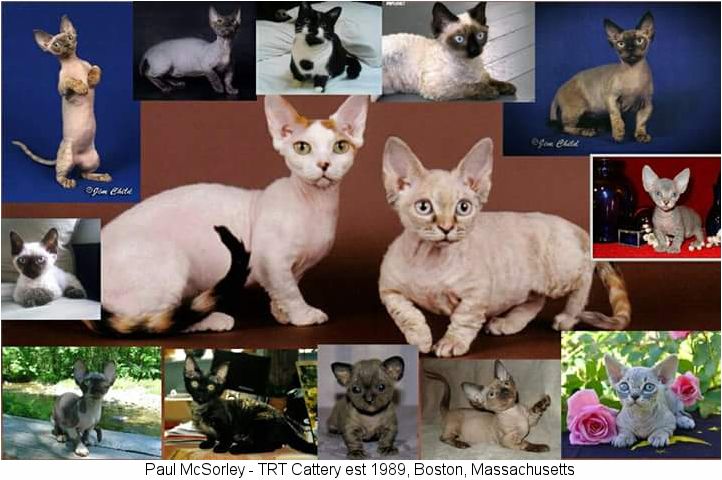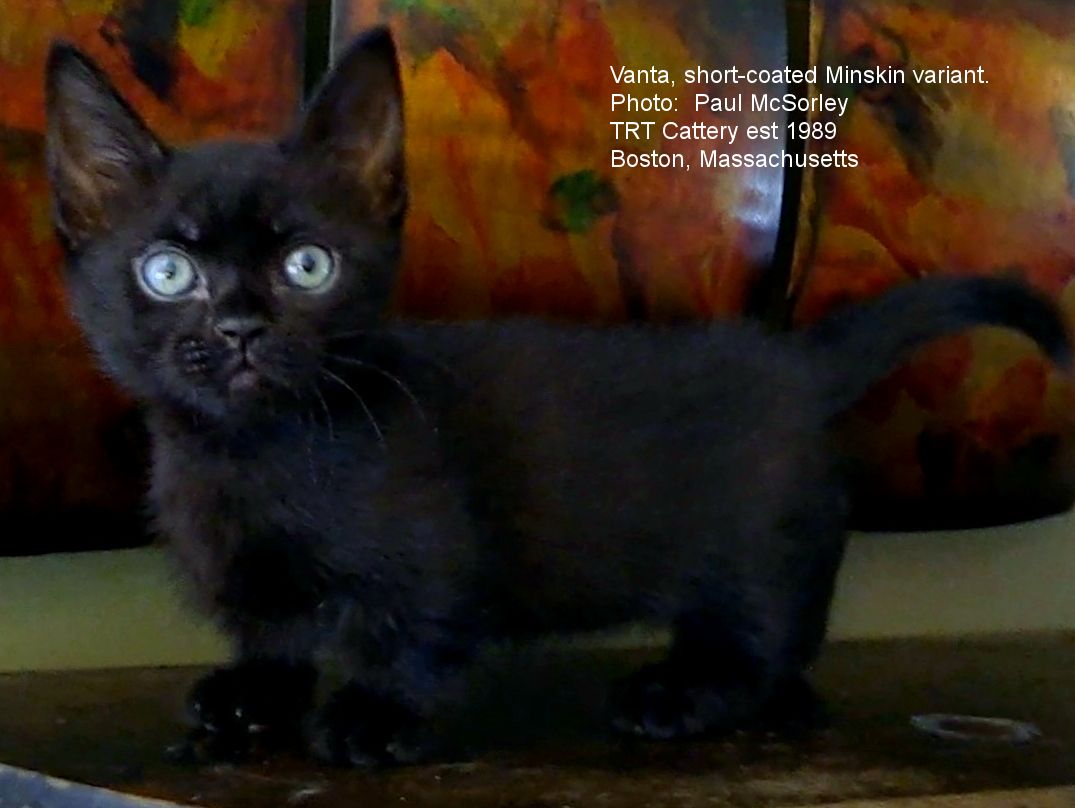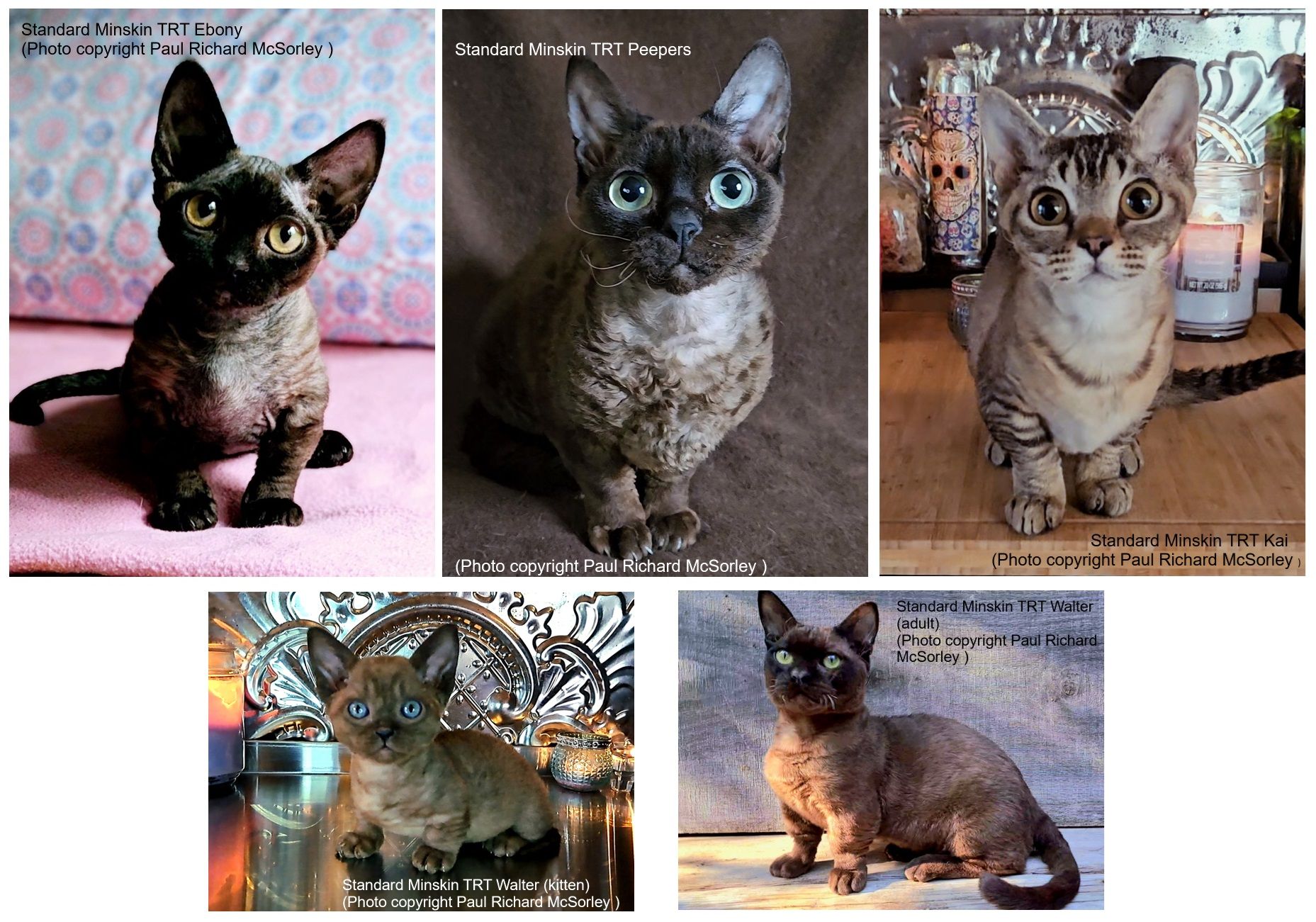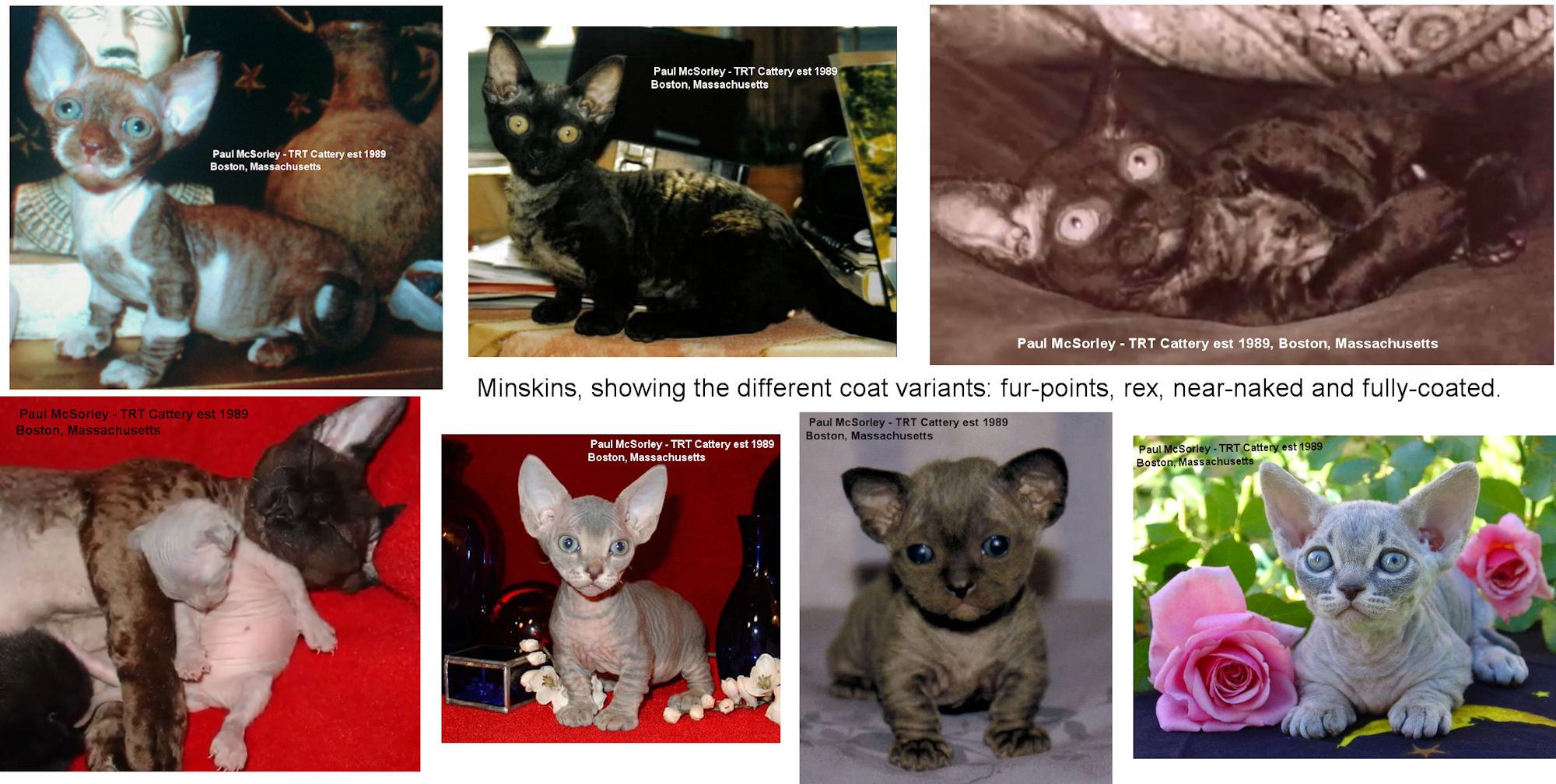|
|
|
|
|
Minskin photos courtesy of Paul McSorley, www.minskin.com |
||
DWARF AND MINI HAIRLESS CATS
Fur: Hairless Cats
Fur: Dwarf and Mini Hairless Cats
Fur: Hairless Cats: Fictional Hairless Cats
Fur: Hairless Cats: Mexican Hairless, or Aztec Cat
The hairless trait has been combined with other traits, including short legs to produce new breeds. The Minskin, developed by Paul McSorley, combines the Munchkin's short legs with the Canadian Sphynx's hairlessness. It is neither a short-legged Sphynx nor a hairless Munchkin, but has its own unique look strongly influenced by the American Burmese. The Sphynx and closely related Devon Rex (about 50/50 ratio) were used only to introduce their distinctive coat genes to produce the unique Minskin "fur points" that are the breed’s trademark. It was this unique "fur-pointed" coat description that was the "unique trait" required for recognition. While Sphynx are bald and Devon Rex are fully rex coated, the in-between kittens ("fuzzies") were either culled or homed as pets. The Minskin is therefore a mix of four breeds in the following order of importance: 1) Munchkin; 2) Burmese; 3) Devon Rex; 4) Canadian Sphynx.
MINSKIN
The Minskin began development in 1998 in Boston, Massachusetts and the first cat of the desired Minskin type was born in July 2000. By 2005, about 50 breed-standard Minskins existed with a further 100 Minskin variants (short-legged cats can produce long-legged offspring). It is currently only recognised by TICA in the USA and is classed as a hybrid breed as it is derived from 2 pre-existing breeds. It got its name for "Min" (miniature legs) and "skin" (sparse coat and hairless belly).
|
|
|
|
|
Minskin photos courtesy of Paul McSorley, www.minskin.com |
||
The conformation is semi-cobby and the coat type is "cashmere" with furred points. Unlike the Sphynx or Bambino, Minskins are not hairless. "Fur-points" are defined by the density of the fur on the cats' extremities in comparison to the rest of the body. The facial mask, ears, legs and tail have closely packed fur which has a textured satin sheen, especially on the legs. The body is sparser coated and has the look and feel of a soft cashmere garment. The fur-point trait is a recessive trait involving polygenes (multiple genes) that govern the actual length of the coat. The coat is described as non-shed which means minimal or barely noticeable shedding (moulting). As with the Sphynx, Minskins feel warm to the touch. All colours and patterns are allowed and colourpoint is a favourite.
The semi-cobby conformation means Minskins are noticeably stocky and small with a rounded head. The eyes are large and round and the face has a sweet expression and a "hobbit-like" appearance. The appearance remains kitten-like, even when fully grown into a small/medium size cat. As with the Munchkin parent, the short stature and does not impair their mobility or quality of life. As well as having a sweet appearance, the Minskin has a sweet temperament. Minskins are described as being outgoing, sweet, playful (but not destructive) and people-oriented.

TRT Vanta, the short-haired Minskin variant shows an interesting trait in the breed - coarse hair in carriers of the fur-pinted trait. Panda (the black-and-white cat , top centre in collage) was the first coated Minskin carrying the fur-pointed trait related to Devon Rex and Sphynx Hairlessness, and she had noticeably coarse fur texture; not wire-haired, but definitely lacking in sheen and lustre. Her unusual "rough textured coat" was observed by TICA Judge and geneticist Dr. Solveig Pflueger. This "dull coat" was commonly seen in coated cats carrying the recessive gene for rex coat/fur-points. This was a good indicator for identifying which coated cats carried the recessive fur-pointed trait and would produce some fur-pointed kittens when bred together. It could also indicate which of the coated kittens did not have the recessive gene. This is important when outcrossing to American Burmese to widen the gene pool. The black short-coated kitten, Vanta, has the dull coat indicative of the presence of the recessive fur-pointed trait.

(This is similar to the situation with the (dominant) Russian Hairless gene where breeders can predict the texture of the residual hair and posit 2 modifiers – one that weakens hairlessness and one that improves hairlessness. In a coated breed, the now-extinct Bramble, the preferred texture was brush-coated, showing that cats do have genes that affect the coat texture. In addition, while most Sphynx are due to one gene mutation, but there are other hairless mutations in the breed and a few phenotypic Sphynx, born from pedigree Sphynx, have tested negative for the most common mutation. In pre-DNA test days, spontaneous hairless cats were added to the breed, but might have had a different mutation.)

Paul McSorley provided this Minskin update in November 2024. The first standard Minskins were born in 2000. 2025 will be the breed's 25th anniversary.
Paul took a short break from breeding and pin all his hopes on one of his best loved cats, TRT Panda, a black and white straight-coated girl (a "furry Minskin"). Shorthaired Minskins lack rex fur-points and resemble a Munchkin. Sadly, after two litters, Panda never produced any more kittens. In 2018 Paul relaunched his breeding program with the few he had and with a few "starter cats". Once he was actively involved again, interest in the breed increased. The few breeders working with Minskins asked for his guidance in improving their lines, and that advice was to get a Burmese, and to pick the one that looks like an owl. Minskins had been built upon a foundation of his established, international award winning Burmese cats. He then bred munchkins with them and later introduced a limited amount of Devon Rex and Sphynx, but it was the Burmese that gave Minskins their magic. Over the years the Burmese factor had become too diluted in the general Minskin population and gene-pool.
By 2020 he was producing kittens and all proceeds from them went into upgrading his cattery. His advice to other breeders paid unexpected dividends when he bought a kitten from each of those he had encouraged to get Burmese, and by 2021, 100% of his cattery was Burmese x Minskin with a couple of Burmese x Devon Rex. He knew that he was taking the longer, more difficult road this way, but felt it necessary: he was rebuilding my cattery from scratch and wanted to do it right by following the same method that he had used the first time, but doing it better. He was able to incorporate his original lines when he located an intact male from those lines and mated a female to him, resulting in "Griffin" who became Paul’s primary stud cat.
Sparing no expense and making no compromises, he imported three cats; one from Russia and two from Belarus. The Minskin breed had become something far bigger than he had anticipated, spreading to other countries, and he believed they deserved a place in the championship class. With their looks and their wonderful personalities, he wants the Minskin to be his legacy.
BAMBINO
A hybrid of Sphynx and Munchkin has produced the Bambino (Italian for "baby" and alludes to their mischievous personalities) with a wedge-shaped head, wide set eyes, short, squarish muzzle and lynx-tipped ears set well onto the top of the head rather than flared outwards. It is a muscular, medium-boned cat. The coat varies from hairless to peach-fuzz and all colours and patterns are allowed. Bambino Long-Legs variants occur.
DWELF. UKRAINIAN LEVKOY, SPHYNXKIN
The Dwelf also combines curl ears with hairlessness and short legs, and adds Highlander (a bobtailed, curl-eared polydactyl breed) to the mix. These combine hairlessness, curled ears and short legs. Non-standard (long legged) Dwelfs resemble the hairless curl-eared Elf breed. The Ukrainian Levkoy is derived from the Don Sphinx and Scottish Fold to produce a naked breed whose ears do not fold as tightly as the Scottish Fold, but stand out from the head and fold closer to their tips.
A Sphynxkin was also reported as an intended fully hairless Munchkin/Sphynx crossbreed, but never materialised and seems to have been a backyard cross-breed with a marketing name. The Mynx was reported to be a Manx/Sphynx crossbreed and was strongly discouraged because of side-effects of the Manx gene. The breed proposer was apparently attempting to obtain foundation cats, but there was no further news of breed development so presumably it was not developed further.
In 2005, TICA clamped down on new breeds based on the Munchkin trait as this had become an increasing trend with the temptation to produce short-legged variants of existing breeds. This prevented further progression of the Minskin and Bambino breeds and the exclusion of the Dwelf, Elf and Levkoy. These breeds now tend to be recognised by WCF (World Cat Federation) which is very active in Russia and neighbouring countries, and the paper registry REFR.
For more information on the Munchkin, Minskin and other short-legged breeds please see
Short-Legged Cats.